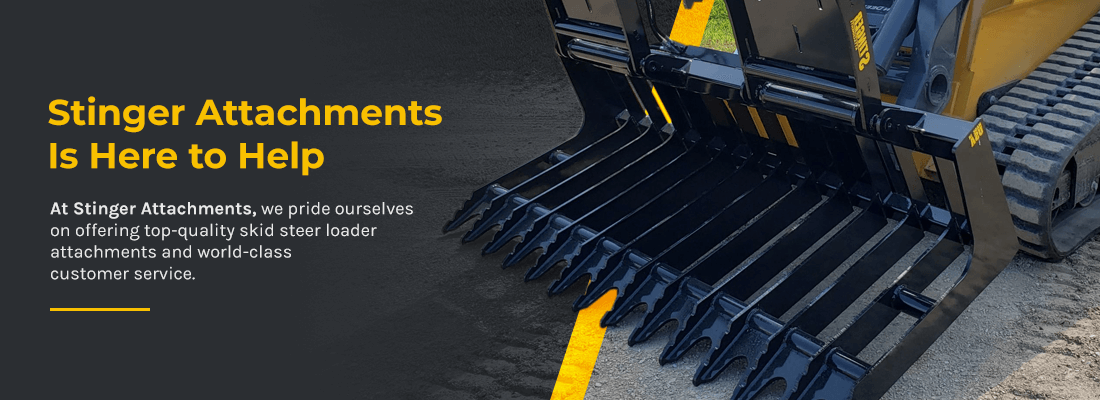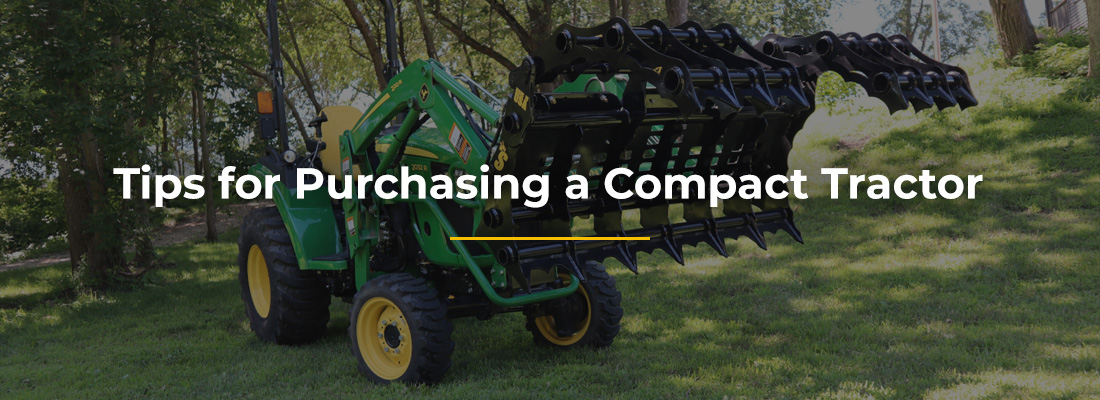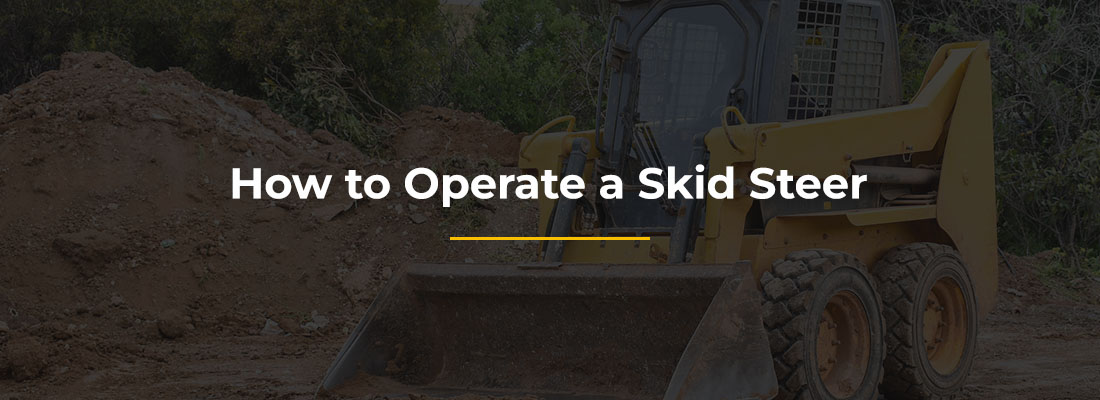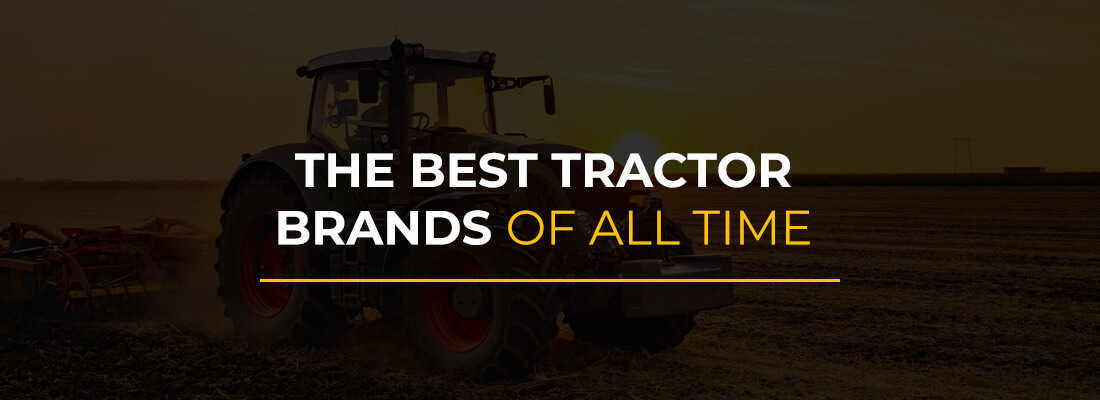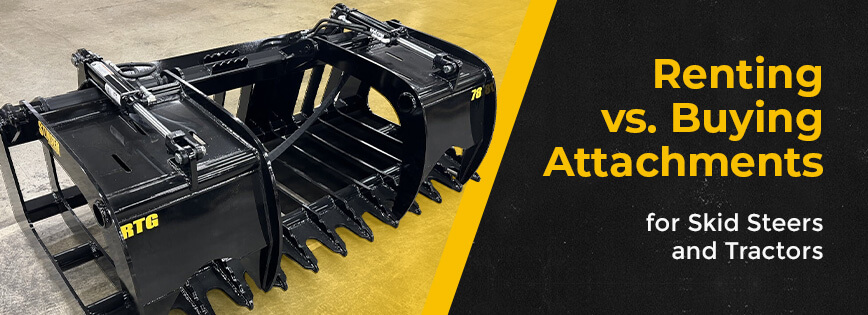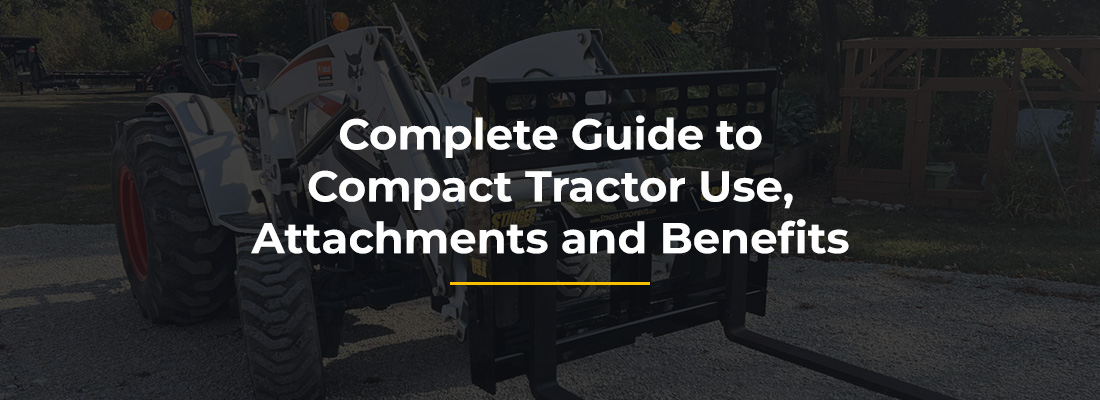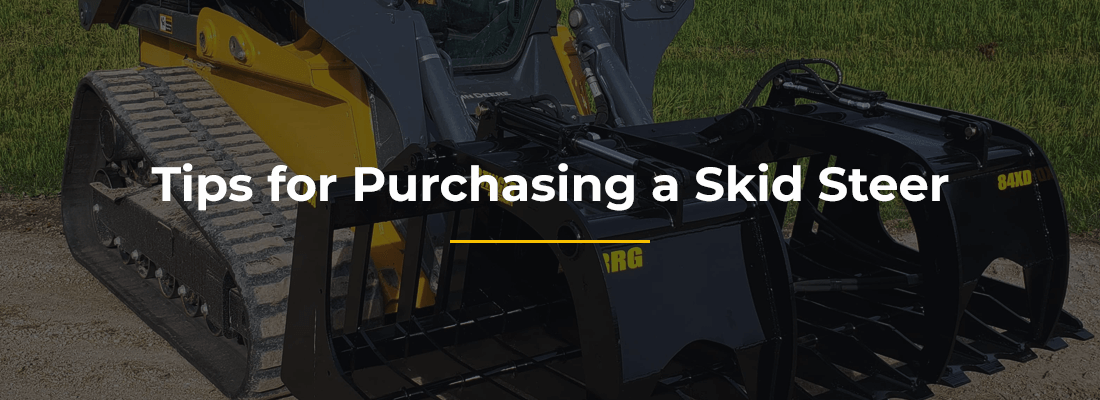
Tips for Purchasing a Skid Steer
Skid steer loaders are ideal for many people because they are such a versatile piece of machinery. You can use them for land clearing, brush removal, excavation, snow removal, demolition and landscaping. But how do you know which skid steer is the right one for you? Before you invest in your next piece of equipment, you should consider exactly what you need and decide if you’re going to buy new or used.
Whether you’re scaling up production around the farm, adding a new machine to your fleet or just want to know which skid steer is best for your landscaping project, Stinger Attachments is here to help.
Table of Contents
- Choosing the Best Skid Steer for Your Project
- Should I Buy a New or Used Skid Steer?
- Tips for Buying a Used Skid Steer
- Tips for Buying a New Skid Steer
- Buying a Skid Steer: Frequently Asked Questions
- Stinger Attachments Is Here to Help
Choosing the Best Skid Steer for Your Project
Before you start shopping for the right skid steer, determine your specific needs and requirements, including:
- What you will use your skid steer for the majority of the time — whether lifting, digging or demolishing
- Worksite conditions, including the type and level of terrain you will be operating on
- The height and width of important project factors, such as vegetation or standing structures
- The types of equipment you or your team already know how to operate
- Your budget for the initial investment, relevant attachments and ongoing maintenance
- How often you intend to use your machine
When you have a better idea of what you’re looking for, keep this information in mind while assessing the specifications of potential skid steers.
Know What You Need
Weight and horsepower are some of the biggest determinants when deciding which skid steer loader will work. The following are the different skid steer classifications as determined by the Associated Equipment Manufacturers:
- Small skid steers: Small skid steers generally have less than 50 horsepower and a lift capacity of 1,750 pounds or less. They are ideal for easy towing and hard-to-navigate areas.
- Medium skid steers: Medium skid steers have between 50 and 70 horsepower and a lift capacity of 1,750 to 2,200 pounds. These machines are suitable for projects that need a little more power than a small machine without sacrificing easy maneuverability and towing.
- Large skid steers: Large skid steers possess a carrying capacity of 2,200+ pounds and have 70 or higher horsepower. If your project calls for a powerful, hardworking machine, a large loader might be a good fit.
Several other factors contribute to whether a certain skid steer loader is suitable for your needs, including:
- Operating capacity: Sometimes referred to as “lift,” the rated operating capacity is how much weight a machine can safely carry while remaining stable, level and functional.
- Lift type: Skid steers are available two lift variations — radial or vertical. In radial lift machines, the skid steer’s arms move outward and then upward, which provides more forward reach for digging or similar actions. A vertical lift skid steer moves its arms directly up or down, which makes it useful for loading or hauling.
- Features: In addition to skid steer attachments, you will need to choose between optional features and amenities that can make your machine easier or safer to use. Some examples include air conditioning, a radio, heated seats and rearview cameras.
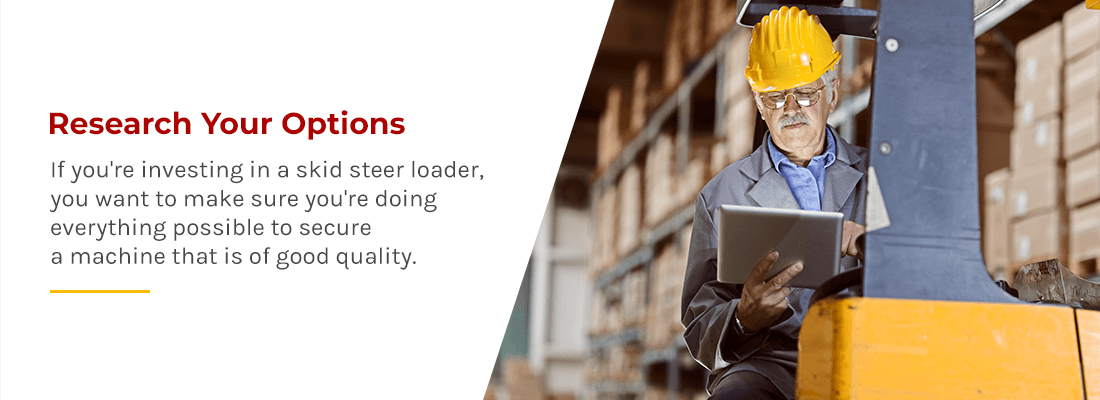
Research Your Options
If you’re investing in a skid steer loader, you want to make sure you’re doing everything possible to secure a machine that is of good quality. To do this, research the following:
- Manufacturers: There are several skid steer manufacturers on the market. Choose one that has a good reputation, positive customer testimonials and makes it easy to find replacement parts if necessary.
- Dealerships: Working with a professional new or used skid steer dealership is a good place to start your search because they are familiar with the process and various industry applications. Be sure to read reviews and testimonials about a dealership before choosing to work with them.
- New or used condition: Finally, decide whether you want to shop for a new or used machine. Each option has its advantages, so the decision comes down to your specific wants and needs.
Should I Buy a New or Used Skid Steer?
Before you decide whether to buy new or used, let’s take a look at the advantages of each.
Purchasing a new skid steer can give you great peace of mind because you know the machine has never been used before. There are several other advantages to buying new, including:
- Latest technology: When you buy new, you can choose a machine that has all the latest technology built-in, such as hydraulic systems, digital screens and self-leveling capabilities.
- Operating condition: A new machine is nearly guaranteed to be in optimal working condition. In the rare event of a manufacturing defect, the dealer or manufacturer is there to help.
- Available options: If you’re looking for a specific skid steer brand or newer model, you will likely have an easier time finding it than you would if you were shopping for a used machine.
Of course, new machines require a larger initial investment. Keep this in mind, especially if you do not plan to use your skid steer regularly.
When staying within budget is your top priority, a used machine can be the perfect investment for you or your business. Some advantages of buying used are:
- Initial cost: A used machine costs less upfront than a new machine of the same caliber. You can reallocate the money saved upon initial investment toward other areas of a business or project.
- Value and depreciation: Unlike new equipment, a used skid steer will have already depreciated over time. This means you have a higher chance of reselling the skid steer in the future for a near-equal amount to the purchase price, assuming it is well cared for.
- Minimal limitations: Buying used heavy equipment has become a more streamlined process than ever before. Several dealers focus specifically on used equipment and have access to extensive networks of machinery that fit your specifications.
When purchasing used, you are not always guaranteed excellent quality. That doesn’t mean you can’t buy a well-performing used machine — in fact, used skid steers are the best investment option for many people. However, you must take care to research the dealer and inspect the machine thoroughly before finalizing the deal.
Tips for Buying a Used Skid Steer
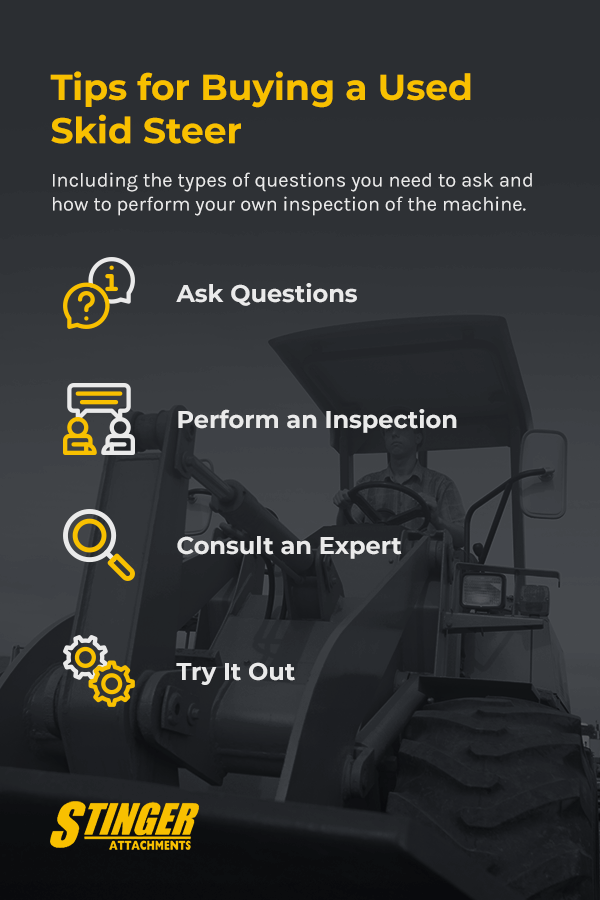
Buying a used skid steer can be a sound financial decision, and there are many options for used models on the market today. These are some tips for buying a skid steer used, including the types of questions you need to ask and how to perform your own inspection of the machine.
1. Ask Questions
Don’t be afraid to ask questions when looking at a used skid steer. Asking questions is the best way to protect your investment and make sure you’re getting a fully operational machine. A reputable seller will be prepared to answer your questions. If a seller seems hesitant or unwilling to cooperate, you might consider searching elsewhere.
Questions you should always ask the seller include:
- How many people have owned this skid steer?
- What are the total miles and operating hours of the machine?
- What is the status of the title?
- Is the seller the owner of the machine?
- What quality checks has the seller conducted on this skid steer?
- What types of projects was this skid steer used for in the past?
- Do you have a warranty or return policy?
- Has this skid steer ever needed to be repaired?
- Does this machine have all the original parts? If not, are the current parts from the same manufacturer?
Although this is not an exhaustive list, these questions are a great place to start when discussing a used machine with an individual or dealership. Note their answers and make sure they line up with the research you’ve done, including inspections and seller reviews. If you have any doubts about the machine’s origins, you can give the authorities the skid steer’s serial number or product information number to make sure it doesn’t match any reported missing.
2. Perform an Inspection
You don’t have to be an expert in heavy equipment to perform a quick visual inspection of a prospective skid steer. As you’re inspecting the machine, pay close attention to the following concerns:
- External wear and tear, including dents, scratches, cracks, scuffs, rust and holes
- Internal wear and tear, including a scratched or ripped seat
- Tire condition, including worn tread
- Dirty or expired oil in the transmission or engine
You’ll also want to assess the skid steer’s appearance, as well as any other machinery and equipment present. Do they look like they have been well cared for and maintained, or is the area dirty and littered with broken down machinery? Sometimes, small details can give you lots of insight into how well the seller has maintained a piece of equipment.
3. Consult an Expert
If you’re buying a used skid steer — especially if purchasing from an individual or unauthorized dealer — have a heavy equipment expert or mechanic come with you to perform their own inspection. A trained professional will be able to spot potential red flags you might not know to look for. If the skid steer is in good condition, additional confirmation from a mechanic can help you feel even more at ease as you complete the transaction.
4. Try It Out
The best way to get a feel for how a used machine performs is by testing it out yourself. After getting approval from the seller, test the skid steer’s performance in the following areas:
- Functionality: Testing for functionality includes making sure the steering and controls work smoothly, the lights turn on and off, the machine is easy to start and the loader arms work as they should.
- Safety: Seeing or smelling smoke from any part of the machine when running indicates a significant issue. You should also test that the parking brakes work, and the seat belt fastens securely and comfortably.
- Comfort: Finally, how does it feel to operate the skid steer? Sometimes, even well-maintained machines may not be a good fit for you or your project. Make sure the seat is comfortable and that you can easily reach all controls. Take note of how loud the machine is from both inside and outside the cab.
Tips for Buying a New Skid Steer
With so many options available, buying a new skid steer can be an exciting experience. That said, it might be challenging to know exactly where to start your search. To make it easier, here are some tips for buying skid steers in new condition.
1. Do Your Homework
Although buying a new skid steer doesn’t require as much research and inspection as buying a used machine does, you still have some homework to do. Before you begin browsing dealerships for equipment, take time to learn more about the seller. Make sure they have a positive reputation for selling quality products.
You can learn more about a seller on their website, including testimonial and review pages. However, you should search for reviews from third parties as well. Be sure to ask the seller whether or not they have a warranty and what their return policy is. To make sure you’re taking advantage of everything the seller has to offer, always ask about possible sales, bundling options or shipping discounts before finalizing your purchase.
2. Keep Present and Future Needs in Mind
You probably decided to buy a new skid steer because you have a specific project coming up around your property, or your business has decided to diversify its offerings. Although it might be tempting to narrow your skid steer search to those applicable for your specific needs, it would be best to invest in a piece of equipment that you can use repeatedly for several different applications.
3. Only Invest in What You Need
Today, heavy equipment is more technologically advanced than ever. New machines have built-in features to enhance the quality and comfort of machine operation. Keep in mind that advanced features will likely result in a higher price tag. While many of these features and accessories are nice to have, be selective when choosing which ones are best for you.
If you plan to use your new skid steer for a few projects throughout the year, you are probably not as concerned about comfort-related features. But if your new skid steer is going to be part of your daily work duties, it might be worth spending a little more money on a rig that helps you stay comfortable and focused all day long.
Do not be swayed by optional amenities simply because they are the latest and greatest available. Instead, opt for add-ons that will help you get the most value for your money by making your project go quicker or helping you feel safer.
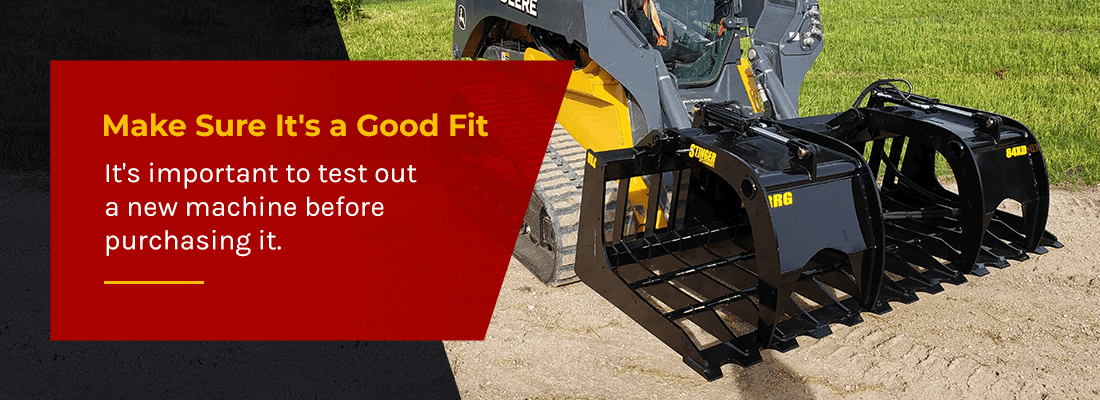
4. Make Sure It’s a Good Fit
It’s important to test out a new machine before purchasing it. While you’re testing the equipment, ask yourself the following questions:
- Is operation comfortable and straightforward, or will there be a significant learning curve?
- Are the controls and steering easily accessible?
- Is the cab comfortable and spacious enough?
- Does this skid steer meet each want, need and specification for my project?
Buying a Skid Steer: Frequently Asked Questions
Once you’ve decided what type of skid steer you need and whether you’re going to shop new or used, you might have a few remaining questions. Here are some frequently asked questions about buying a skid steer:
What Is the Best Time of Year to Buy a Skid Steer?
The best time of year to buy a skid steer depends on a few factors, including the anticipated start date and duration of your project, as well as your current financial situation.
If you do not have a specific manufacturer or skid steer model in mind, give yourself ample time to research, browse and purchase a machine before your project begins. You should also take into consideration any dealer-specific sales and promotional events that could help you save money.
How Many Hours Will a Skid Steer Last?
Some experts say the average lifespan of a skid steer is 5,000 hours. Keep in mind that how long your skid steer lasts depends on several different things, including:
- Whether you purchased the equipment in new or used condition.
- The type and difficulty of the work you are using the skid steer for.
- How frequently you use your skid steer.
- How well you maintain your machine.
As long as you take the time to find a high-quality product and take good care of it, you will likely enjoy your skid steer for years to come.
Which Attachments Are Available for My Skid Steer?
One of the best things about investing in a skid steer is that you can use different attachments to complete a variety of tasks. Some popular skid steer attachments include:
- Land planes for smoothing, grading and tilling.
- Tooth buckets for digging, tree removal and hauling.
- Tree pullers for removing vegetation, rocks and debris.
- Grapples for collecting and transporting rocks, scraps and work materials.
- Material buckets for hauling rocks, sand, dirt and livestock feed.
- Bale spears for private and commercial farming.
When searching for skid steer attachments, approach the buying process with the same caution and research as you use when purchasing your skid steer. Always make sure the attachments are compatible with your specific machine. Fortunately, our attachments fit machines from all of the top brands, including New Holland, John Deere, Kubota, Bobcat, Case, and many more!
Stinger Attachments Is Here to Help
At Stinger Attachments, we pride ourselves on offering top-quality skid steer loader attachments and world-class customer service. If you have a question about buying a new or used skid steer, contact us or give our team a call at 507-273-7497. We would be happy to help you make the best decision for you or your business.
You can also browse our inventory to find the best skid steer attachments for your next project today.

